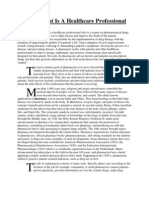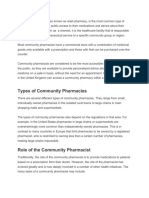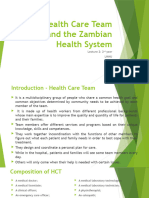0 ratings0% found this document useful (0 votes)
43 viewsPharmacy (Shop) : Green Cross Is The Symbol of Pharmacies
Pharmacy (Shop) : Green Cross Is The Symbol of Pharmacies
Uploaded by
prabakar VA pharmacy is a retail shop that provides pharmaceutical drugs and healthcare services. At the pharmacy, a pharmacist oversees filling prescriptions and provides advice on medications. Consumers benefit from choosing a pharmacy where they have easy access to a pharmacist. Pharmacies also offer additional services like vaccinations and technology to help prevent errors. Pharmacists are responsible for dispensing drugs properly and counseling patients on health, disease prevention, and medication use.
Copyright:
© All Rights Reserved
Available Formats
Download as DOCX, PDF, TXT or read online from Scribd
Pharmacy (Shop) : Green Cross Is The Symbol of Pharmacies
Pharmacy (Shop) : Green Cross Is The Symbol of Pharmacies
Uploaded by
prabakar V0 ratings0% found this document useful (0 votes)
43 views4 pagesA pharmacy is a retail shop that provides pharmaceutical drugs and healthcare services. At the pharmacy, a pharmacist oversees filling prescriptions and provides advice on medications. Consumers benefit from choosing a pharmacy where they have easy access to a pharmacist. Pharmacies also offer additional services like vaccinations and technology to help prevent errors. Pharmacists are responsible for dispensing drugs properly and counseling patients on health, disease prevention, and medication use.
Original Title
priyadharshi
Copyright
© © All Rights Reserved
Available Formats
DOCX, PDF, TXT or read online from Scribd
Share this document
Did you find this document useful?
Is this content inappropriate?
A pharmacy is a retail shop that provides pharmaceutical drugs and healthcare services. At the pharmacy, a pharmacist oversees filling prescriptions and provides advice on medications. Consumers benefit from choosing a pharmacy where they have easy access to a pharmacist. Pharmacies also offer additional services like vaccinations and technology to help prevent errors. Pharmacists are responsible for dispensing drugs properly and counseling patients on health, disease prevention, and medication use.
Copyright:
© All Rights Reserved
Available Formats
Download as DOCX, PDF, TXT or read online from Scribd
Download as docx, pdf, or txt
0 ratings0% found this document useful (0 votes)
43 views4 pagesPharmacy (Shop) : Green Cross Is The Symbol of Pharmacies
Pharmacy (Shop) : Green Cross Is The Symbol of Pharmacies
Uploaded by
prabakar VA pharmacy is a retail shop that provides pharmaceutical drugs and healthcare services. At the pharmacy, a pharmacist oversees filling prescriptions and provides advice on medications. Consumers benefit from choosing a pharmacy where they have easy access to a pharmacist. Pharmacies also offer additional services like vaccinations and technology to help prevent errors. Pharmacists are responsible for dispensing drugs properly and counseling patients on health, disease prevention, and medication use.
Copyright:
© All Rights Reserved
Available Formats
Download as DOCX, PDF, TXT or read online from Scribd
Download as docx, pdf, or txt
You are on page 1of 4
PHARMACY (SHOP)
GREEN CROSS IS THE SYMBOL OF PHARMACIES.
A pharmacy (also called "drugstore" in American English or "community
pharmacy" or "chemist" in Commonwealth English) is a retail shop which
provides pharmaceutical drugs, among other products. At the pharmacy,
a pharmacist oversees the fulfillment of medical prescriptions and is available to give
advice on their offerings of over-the-counter drugs. A typical pharmacy would be in
the commercial area of a community.
CHARACTERISTICS OF A GOOD PHARMACY
The American Association of Colleges of Pharmacy recommends that
consumers choose a pharmacy at which they can have a consulting relationship with
the pharmacist. Anyone using drugs benefits when they have easier access to a
pharmacist. Being timely includes both processing the request quickly and having
drug stock available to fill the prescription. Some consumers need drugs delivered to
their home, perhaps by mail, and may select a pharmacy which offers that
service. Different pharmacies may charge different prices for the same drugs, so
shopping for lower prices may identify a pharmacy offering better value. In addition
to fulfilling prescriptions, a pharmacy might offer preventive healthcare services like
vaccinations. Up-to-date technology at a pharmacy can assist a patient with
prescription reminders and alerts about potential negative drug interactions, thereby
reducing medical errors.
DUTIES
The International Pharmaceutical Federation has declared their vision of a
community-based pharmacist:
An expert in pharmaceutical care, pharmacotherapy and health promotion
A professional communicator with patients, other healthcare providers and
decision makers
Deliver high quality products, services and communication
Document their work and communicate the outcome to professional colleagues.
RESPONSIBILITIES
Community-based pharmacists' responsibilities include: checking and
dispensing of prescription drugs, providing advice on drug selection and usage to
doctors and other health professionals and counseling patients in health
promotion, disease prevention and the proper use of medicines.
In most countries regulations govern how dispensaries may operate, with
specific requirements for storage conditions, equipment and record keeping.
SOCIETY AND CULTURE
A survey conducted by Prescribe Wellness found that almost half of Americans
older than 40 years-old value pharmacies that offer preventative care services, and
would be willing to transfer their prescriptions to pharmacies that offer those
services. Patients also value pharmacies where they can receive medical advice
concerning their prescription medications, how those medications may interact with
each other, and receive over-the-counter drug recommendations for the management
of common ailments. In a survey of over 1,000 U.S. adults older than 40 years-old
conducted by Propeller Insights, 67% of patients responded that they would prefer that
their pharmacist discuss new prescriptions with them, rather than their physician,
because they viewed their pharmacist as "better at explaining side effects and has
more time to spend with them."
REFERENCES
Jump up to:a b c d e f "Pharmacy Buying Guide". Consumer Reports. May 2016.
Retrieved 13 February 2017.
"Community Pharmacy Section". International Pharmaceutical Federation
(FIP). Retrieved 8 July 2014.
"What pharmacists do and where they work". Pharmaceutical Society of
Australia. Archived from the original on 30 March 2014. Retrieved 8 July 2014.
"Pharmacy". Scottish Government. Retrieved 8 July 2014.
"Careers in pharmacy: Pharmacy roles: Community pharmacy". Royal
Pharmaceutical Society (RPS). Retrieved 8 July 2014.
"How the health system is skewed towards harm for pill-popping pensioners".
EconoTimes. 27 November 2015. Retrieved 30 November 2015.
"About community pharmacy". Pharmaceutical Services Negotiating
Committee. Retrieved 30 November 2015.
"Digital hospital-to-pharmacy referral service delayed by six further weeks".
Pharmaceutical Journal. 23 December 2020. Retrieved 1 February 2021.
"About Community Pharmacy". Pharmaceutical Services Negotiating
Committee. Retrieved 8 July 2014.
"Pharmacy in Europe: France". Employed community Pharmacists in Europe
(EPhEU). Retrieved 8 July 2014.
"News from UK". Employed community Pharmacists in Europe (EPhEU).
Retrieved 8 July 2014.
"Independent Pharmacy Today". National Community Pharmacists
Association. Retrieved 8 July 2014.
Gauld, Natalie (8 December 2010). "Sun, surf, snow and pharmacy- pharmacy
practice in New Zealand". PJ online. Retrieved 8 July 2014.
"Principles for Community Pharmacy Agreements". Pharmaceutical Society of
Australia. Retrieved 8 July 2014.
CLINICAL ROLES
It is becoming more common for pharmacists to take on extended roles that
provide more clinical care directly to patients as part of a primary care team. There are
around 11,400 community pharmacies in England. Many are open for extended hours
in the evenings and weekends and they are accessible without appointment.
You might also like
- Community Pharmacy Symptoms, Diagnosis and Treatment by Paul RutterDocument489 pagesCommunity Pharmacy Symptoms, Diagnosis and Treatment by Paul RutterNhi Nguyễn78% (9)
- A Comparative Study of In-House Pharmacy and Retail PharamacyDocument84 pagesA Comparative Study of In-House Pharmacy and Retail PharamacyPreethu Gowda100% (5)
- Community PharmacyDocument7 pagesCommunity Pharmacythayana100% (1)
- Introduction To Community PharmacyDocument9 pagesIntroduction To Community PharmacyMr.Shaz100% (2)
- History of Hospital PharmacyDocument41 pagesHistory of Hospital PharmacyLovely Ann Ayapana69% (16)
- Clinical Pharmacy by Parthsarthi Pages 4Document19 pagesClinical Pharmacy by Parthsarthi Pages 4Shaban SaadNo ratings yet
- The Changing Face of PharmaciesDocument6 pagesThe Changing Face of PharmaciesAijem RyanNo ratings yet
- Your Guide To A Career in Pharmacy A Comprehensive OverviewFrom EverandYour Guide To A Career in Pharmacy A Comprehensive OverviewNo ratings yet
- Community 2Document5 pagesCommunity 2Adia MasooraNo ratings yet
- Pharmacy Daily For Fri 26 Aug 2016 - Remuneration Survey Open, New MedAdvisor NDSS Tool, Mayne Profit Jumps 379%, Events Calendar and Much MoreDocument4 pagesPharmacy Daily For Fri 26 Aug 2016 - Remuneration Survey Open, New MedAdvisor NDSS Tool, Mayne Profit Jumps 379%, Events Calendar and Much MorepharmacydailyNo ratings yet
- Pharmacy AssistantDocument30 pagesPharmacy AssistantSeng MaiNo ratings yet
- Clinical Pharmacy by Parthsarthi Pages 3Document14 pagesClinical Pharmacy by Parthsarthi Pages 3Shaban SaadNo ratings yet
- State of Worlds PharmacyDocument19 pagesState of Worlds Pharmacymadougtraore23No ratings yet
- The Key Role of Sole Community Pharmacists in Their Local Healthcare Delivery SystemsDocument4 pagesThe Key Role of Sole Community Pharmacists in Their Local Healthcare Delivery SystemsasifmassudNo ratings yet
- Contemporary PharmacyDocument10 pagesContemporary PharmacyGerald Limo Arap ChebiiNo ratings yet
- A Pharmacist Is A Healthcare Professional Who Is A Expert On Pharmaceutical Drugs and How They Act To Fight Disease and Improve The Heath of The PatientDocument4 pagesA Pharmacist Is A Healthcare Professional Who Is A Expert On Pharmaceutical Drugs and How They Act To Fight Disease and Improve The Heath of The PatientAjay Sai KumarNo ratings yet
- Jurnal Internasional 11Document12 pagesJurnal Internasional 11dinda mentari putriNo ratings yet
- Walgreen Online PharmacyDocument64 pagesWalgreen Online PharmacyWalgreen Online PharmacyNo ratings yet
- Pharmacy Daily For Mon 23 Jan 2017 - Prescribing Pharmacists?, Advocacy Transparency, Pharmacists Help With Asthma Surge, Weekly CommentDocument3 pagesPharmacy Daily For Mon 23 Jan 2017 - Prescribing Pharmacists?, Advocacy Transparency, Pharmacists Help With Asthma Surge, Weekly CommentpharmacydailyNo ratings yet
- Research Report Scope of PharmacyDocument4 pagesResearch Report Scope of PharmacyNirmal MathankarNo ratings yet
- Revised Drug Information PDFDocument19 pagesRevised Drug Information PDFvaseem9in100% (1)
- The Unveiling of Pharmacy: A Path To Accurate HealthcareDocument4 pagesThe Unveiling of Pharmacy: A Path To Accurate Healthcareoperations writingNo ratings yet
- المحاضرة الأولىDocument31 pagesالمحاضرة الأولىIbrahim HamidNo ratings yet
- Unit 1. Clinical PharmacyDocument5 pagesUnit 1. Clinical PharmacyAashish BhattaraiNo ratings yet
- Types of Community PharmaciesDocument3 pagesTypes of Community PharmaciesJoyce RevitaNo ratings yet
- 4 Fields of Practice of PharmacyDocument28 pages4 Fields of Practice of PharmacyEmmanuel Lomocso Pinsoy Jr.No ratings yet
- 3Document3 pages3operations writingNo ratings yet
- Assignment in PharmacologyDocument3 pagesAssignment in PharmacologyAlrick AsentistaNo ratings yet
- Introduction PC 2017Document20 pagesIntroduction PC 2017ChristinaNo ratings yet
- Pharmacist Role in Dispensing Medicine PDFDocument3 pagesPharmacist Role in Dispensing Medicine PDFNavi JcNo ratings yet
- The Health Team and The Zambian Health SystemDocument49 pagesThe Health Team and The Zambian Health Systemnoahngoma41No ratings yet
- Community Pharmacy and Management NotesDocument75 pagesCommunity Pharmacy and Management Noteskaramveer92610No ratings yet
- Helping Patients Make The Most of Their MedicinesDocument13 pagesHelping Patients Make The Most of Their MedicinesArif ShikalgarNo ratings yet
- 2 Orientation - Pharmacy Practice AreasDocument18 pages2 Orientation - Pharmacy Practice Areaskeziahkyei76No ratings yet
- Ethics in Pharmacy PracticeDocument21 pagesEthics in Pharmacy PracticeLighto Ryusaki100% (1)
- History of Sciences2016Document92 pagesHistory of Sciences2016Saurabh MishraNo ratings yet
- Drug Information Introduction & Sources AvailableDocument35 pagesDrug Information Introduction & Sources AvailableDr pradeepthiNo ratings yet
- Pharmacists Final CindidavisDocument7 pagesPharmacists Final Cindidavisapi-250612122No ratings yet
- Importance of Pharmacists in Indian Healthcare Delivery SystemDocument5 pagesImportance of Pharmacists in Indian Healthcare Delivery SystemDebasish BhattacharjeeNo ratings yet
- Assignment 1 INTRODUCTION TO HOSPITAL PHARMACY PRACTICEDocument5 pagesAssignment 1 INTRODUCTION TO HOSPITAL PHARMACY PRACTICEMae Ann SiarezNo ratings yet
- An Unconventional Pharmacy That Gets Results - Bringing Integrative Medicine To The PharmacyDocument3 pagesAn Unconventional Pharmacy That Gets Results - Bringing Integrative Medicine To The PharmacyImma OlayanNo ratings yet
- Role of Community Pharmacist: BY: Md. Mynul Hasan Southeast UniversityDocument10 pagesRole of Community Pharmacist: BY: Md. Mynul Hasan Southeast UniversityFerdous MostofaNo ratings yet
- Chapter - 1 (Research Problem & Research Gap)Document1 pageChapter - 1 (Research Problem & Research Gap)BIANCA KARLA LICATANNo ratings yet
- A Brief Detail of Community Pharmacy Within PakistanDocument3 pagesA Brief Detail of Community Pharmacy Within PakistanCease fireNo ratings yet
- Pharmacy Is The: Science Drugs Drugs Health Sciences Pharmaceutical Sciences Natural SciencesDocument1 pagePharmacy Is The: Science Drugs Drugs Health Sciences Pharmaceutical Sciences Natural SciencesSherinNo ratings yet
- Capstone Essay: Pharmacist 1Document8 pagesCapstone Essay: Pharmacist 1api-354672148No ratings yet
- Community Pharmacy - An Opportunity For Primary Health Care: Paul SinclairDocument11 pagesCommunity Pharmacy - An Opportunity For Primary Health Care: Paul SinclairMaria Jose Zamorano SepulvedaNo ratings yet
- Hospital and Clinical Pharmacy CH 1 Hospital Pharmacy NotesDocument12 pagesHospital and Clinical Pharmacy CH 1 Hospital Pharmacy Notesmaharachandana18No ratings yet
- Unveiling Pharmacy: Navigating The Path To Precise HealthcareDocument4 pagesUnveiling Pharmacy: Navigating The Path To Precise Healthcareoperations writingNo ratings yet
- PharmacyDocument42 pagesPharmacyOpsonin PharmaNo ratings yet
- DR - Khan Clinical Pharmacy OrientationDocument55 pagesDR - Khan Clinical Pharmacy OrientationIram CHNo ratings yet
- Hospital Clinical Pharmacy CH 1 IMPDocument11 pagesHospital Clinical Pharmacy CH 1 IMPAman SharmaNo ratings yet
- Lecture 1Document41 pagesLecture 1abdulsqureshi2004No ratings yet
- NAB Pharmacy Report 2021Document42 pagesNAB Pharmacy Report 2021marjoriegloduve02No ratings yet
- linking_otcs_1of6_printDocument5 pageslinking_otcs_1of6_printFarmaciaAvilaMagistralPharmNo ratings yet
- Frontline PharmacistDocument5 pagesFrontline PharmacistYet Barreda BasbasNo ratings yet
- Case StudyDocument8 pagesCase StudyTh MaNo ratings yet
- Symptoms in the Pharmacy: A Guide to the Management of Common IllnessFrom EverandSymptoms in the Pharmacy: A Guide to the Management of Common IllnessNo ratings yet
- Vom Otc PDFDocument4 pagesVom Otc PDFAnonymous 45z6m4eE7pNo ratings yet
- Mubiri Joleen ThesisDocument50 pagesMubiri Joleen Thesisprabakar VNo ratings yet
- Anupuram Site - Estimation: SL - No Description AmountDocument1 pageAnupuram Site - Estimation: SL - No Description Amountprabakar VNo ratings yet
- TO WHOM IT BonafideDocument1 pageTO WHOM IT Bonafideprabakar VNo ratings yet
- The Updated IntroDocument2 pagesThe Updated Introprabakar VNo ratings yet
- Axil Scientefic PVT LTD Kattankulathur: To Whom So Ever It May ConcernDocument1 pageAxil Scientefic PVT LTD Kattankulathur: To Whom So Ever It May Concernprabakar VNo ratings yet
- PoovarasanDocument98 pagesPoovarasanprabakar VNo ratings yet
- Strategy of DaburDocument73 pagesStrategy of DaburAsifshaikh7566No ratings yet
- Sample Questions:: Section I: Subjective QuestionsDocument6 pagesSample Questions:: Section I: Subjective QuestionsVinesh AmNo ratings yet
- 7 Binary OperationsDocument23 pages7 Binary Operationshaftu gideyNo ratings yet
- MAD - MINI - PROJECT - TIC - TACK - GAME Mre PDFDocument18 pagesMAD - MINI - PROJECT - TIC - TACK - GAME Mre PDFNishanthNo ratings yet
- Empower A Pi UpdatesDocument10 pagesEmpower A Pi Updatesh_eijy2743No ratings yet
- Connections Remembered, Forgotten and NeglectedDocument4 pagesConnections Remembered, Forgotten and NeglectedNorm FriesenNo ratings yet
- LIDAR, Ultrasonic and GPSDocument37 pagesLIDAR, Ultrasonic and GPSGokul Thalapthy Harish KumarNo ratings yet
- PISA 2018 Assessment and Analytical FrameworkDocument308 pagesPISA 2018 Assessment and Analytical Frameworkwidhy hastutiNo ratings yet
- Quiz 4 Plot and Graph AnsDocument4 pagesQuiz 4 Plot and Graph AnsCh asimNo ratings yet
- IndianJAnaesth63136-5446753 150747Document6 pagesIndianJAnaesth63136-5446753 150747deepikaNo ratings yet
- The Ultimate EDM Production GlossaryDocument15 pagesThe Ultimate EDM Production GlossaryAmit ChatterjeeNo ratings yet
- Chapter Iii - Part 2 - Gec 5Document8 pagesChapter Iii - Part 2 - Gec 5unicuss18No ratings yet
- 1 s2.0 S0304423822006112 MainDocument10 pages1 s2.0 S0304423822006112 MainJOSE ANTONI FRAN RAMOS SANCHEZNo ratings yet
- Joint Danube Survey 3 PDFDocument369 pagesJoint Danube Survey 3 PDFdaniNo ratings yet
- Department of Education: Science 7Document5 pagesDepartment of Education: Science 7Maria Novy PintoNo ratings yet
- OPUS ProgrammingDocument343 pagesOPUS ProgrammingFredrick MutungaNo ratings yet
- Sunan An-NabiDocument214 pagesSunan An-NabialishahidjumaNo ratings yet
- Case - 01475881Document4 pagesCase - 01475881vaibhav_9090No ratings yet
- TAREA 1 InlgesDocument4 pagesTAREA 1 InlgesDiego ArmijosNo ratings yet
- Clivet-2003-1C Air Cooled Module Chiller and Mini Chiller-H3326 - WCAN WGANDocument23 pagesClivet-2003-1C Air Cooled Module Chiller and Mini Chiller-H3326 - WCAN WGANremigius yudhiNo ratings yet
- CM Strat YipDocument9 pagesCM Strat Yipmeherey2kNo ratings yet
- Principles of Disease and EpidemiologyR1Document35 pagesPrinciples of Disease and EpidemiologyR1Biancia MckenzieNo ratings yet
- Theory of EquabilityDocument7 pagesTheory of EquabilitySwarnav MajumderNo ratings yet
- Bản PDF 400 Câu Phát Âm Tiếng Anh Cực Hay Giúp Bạn Ôn Luyện Thi Thpt Quốc Gia Dễ DàngDocument3 pagesBản PDF 400 Câu Phát Âm Tiếng Anh Cực Hay Giúp Bạn Ôn Luyện Thi Thpt Quốc Gia Dễ DàngMỹ Lệ Trịnh ThịNo ratings yet
- Article 1 Homonyms PDFDocument23 pagesArticle 1 Homonyms PDFNuel Angelo SabateNo ratings yet
- Facade NotesDocument303 pagesFacade NotesKho C Ahl100% (2)
- PRESENTOR 2 OrApple Orange Peels and Apple Cider VinegarDocument91 pagesPRESENTOR 2 OrApple Orange Peels and Apple Cider VinegarGerald Sulo - JAMES WATTNo ratings yet
- UPSMF Prospectus 2024 25Document26 pagesUPSMF Prospectus 2024 25n30811302No ratings yet
- Cell SeminarDocument72 pagesCell SeminarDr. Muhammad Ateeq QureshiNo ratings yet
- Kuliah 8Document35 pagesKuliah 8Nabila Madya MandaNo ratings yet































































































